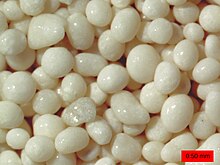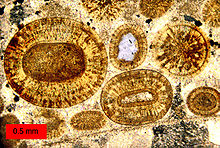Oolite



Oolite or oölite (from
Composition
Ooids are most commonly composed of
They are usually formed in warm, supersaturated, shallow, highly agitated marine water intertidal environments, though some are formed in inland lakes. The mechanism of formation starts with a small fragment of sediment acting as a 'seed', such as a piece of a shell. Strong intertidal currents wash the 'seeds' around on the seabed, where they accumulate layers of chemically precipitated calcite from the supersaturated water. The oolites are commonly found in large
Oolites are often used in the home aquarium industry because their small grain size (0.2 to 1.22 mm) is ideal for shallow static beds and bottom covering of up to 1" in depth. Also known as "oolitic" sand, the sugar-sized round grains of this sand pass easily through the gills of gobies and other sand-sifting organisms. This unusually smooth sand promotes the growth of bacteria, which are important biofilters in home aquaria. Because of its extremely small grain size, oolitic sand has a lot of surface area, which promotes high bacterial growth.
Occurrence
The examples and perspective in this section may not represent a worldwide view of the subject. (January 2023) |
Some exemplar oolitic
The
One of the world's largest freshwater lakebed oolites is the Shoofly Oolite,
This type of limestone is also found in
Oolites also appear in the Conococheague limestone, of Cambrian age, in the Great Appalachian Valley in Pennsylvania, Maryland, West Virginia, and Virginia.
Rogenstein is a term describing a specific type of oolite in which the cementing matter is
See also
- Geologic time scale – System that relates geologic strata to time
- Pearl – Hard object produced within a living shelled mollusc – also formed from concentric layers of calcium carbonate
- Oolitic aragonite sand – Sand composed of an egg-like form of aragonite
References
- ISBN 978-0-7112-5684-2.
- ^ "Oolite". Kansas Geological Survey. Retrieved October 8, 2021.
- ISBN 1-85471-044-3.
Oolitic limestones … are among the most popular building stones and include Portland stone and Bath stone
- ^ "Miami Limestone". USGS. Retrieved May 7, 2019.
- ^ "Mud Flat Oolite". www.blm.gov. 2015-05-28. Archived from the original on 2016-03-06. Retrieved 2016-03-04.
External links
 Media related to Oolite at Wikimedia Commons
Media related to Oolite at Wikimedia Commons Ooids and oolite at Wikibooks
Ooids and oolite at Wikibooks
